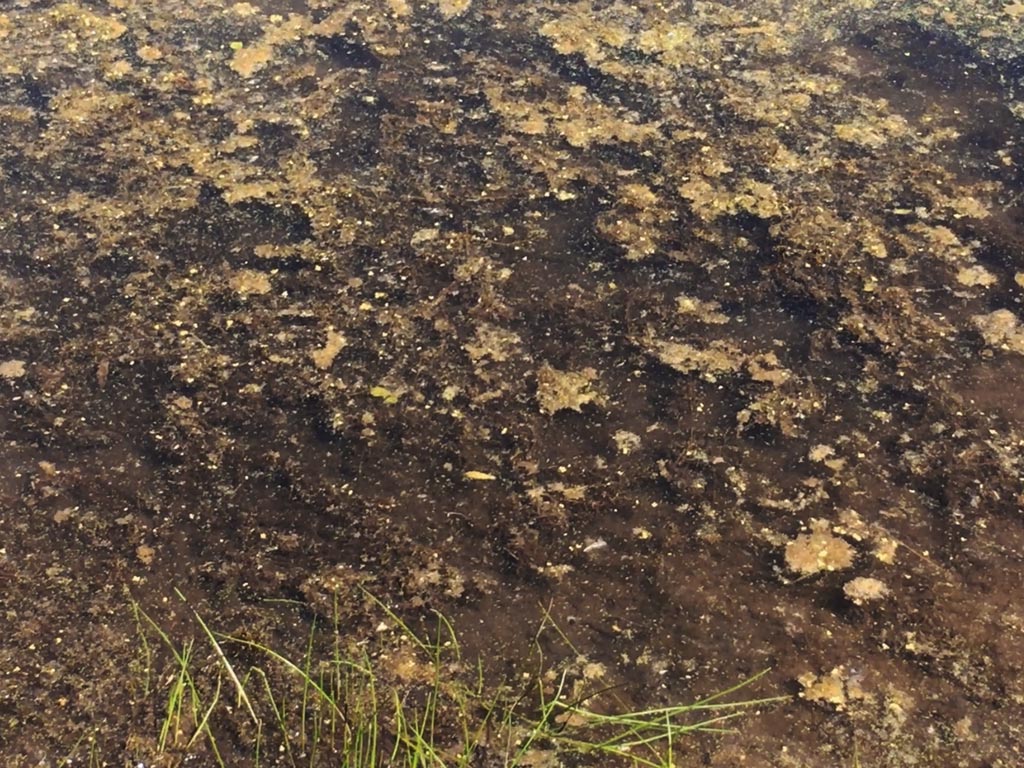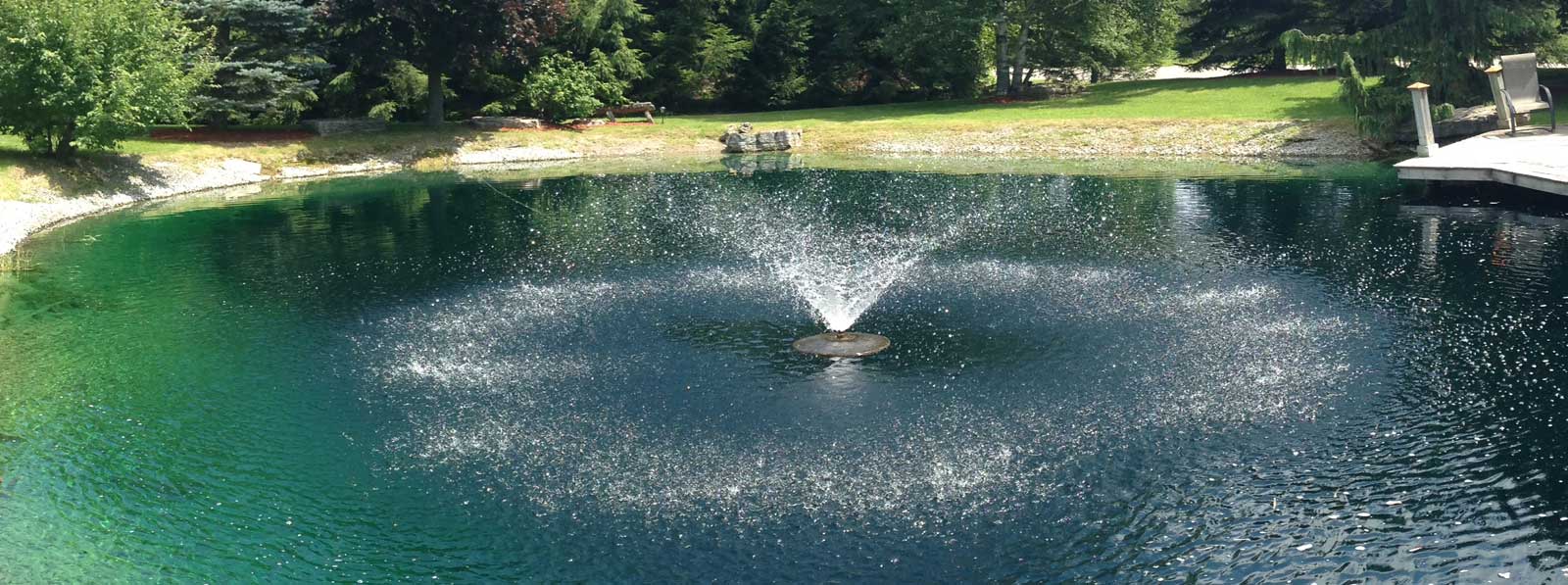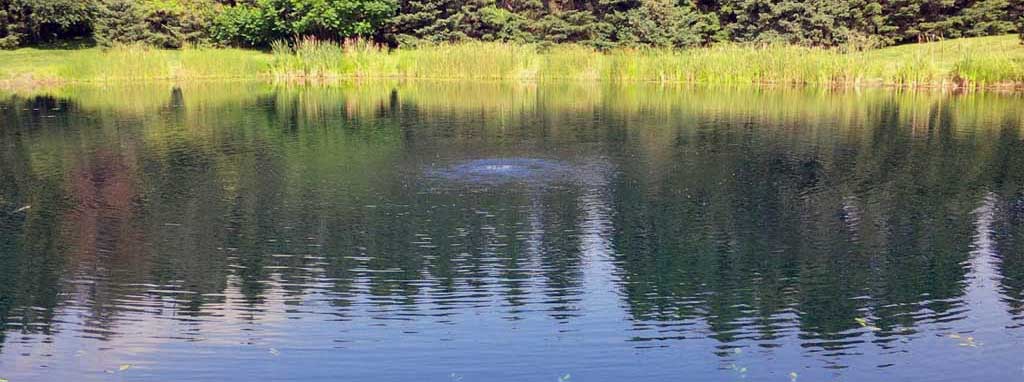The accumulation of pond muck and sludge is one of the most common problems in large natural ponds. Although it can’t always be seen, muck, sludge and organic matter that builds up on the bottom of large ponds is usually the cause of many of the other problems that occur in ponds. In most cases, excessive algae growth, green or murky water, rampant growth of pond weeds or floating duckweed covering a pond is the result of nutrients being released into the water from the sludge layer on the bottom of the pond.

Each year, this layer of organic sediment increases as falling tree leaves, fish waste, dying algae and plant matter enter the pond. Not only does this this sludge consumes oxygen causing poor water quality, it also releases nutrients into the into the water which feed algae, submerged weeds and shoreline plants such as cattails.
Typically, new ponds don’t show an signs of muck accumulation or algae / weed growth, however ponds over 5 years old usually start to show their age. The most common indicator that a pond has a heavy layer of sludge is that it becomes overgrown with filamentous algae such as spirogyra or chara. This often takes the form of ‘green slime’ growing around the perimeter of the pond, especially in shallow areas that where the water warms up quickly.
In a pond without aeration, oxygen levels at the bottom of the pond become very low during the summer . In these ponds, sludge accumulates faster than it can be broken down, leading too an increasing layer of muck. Ponds with many trees nearby that drop large amounts of leaves in the pond, can accumulate sludge at an alarming rate.
In low oxygen environments, such as pond with a thick layer of sludge, anaerobic bacteria will begin digesting the organic matter. However, these ‘bad’ bacteria digest sludge very slowly and produce toxic gases such as ammonia, methane and hydrogen sulfide (rotten egg smell). Sludge will build up much faster than it can be digested, leading to an increasing layer of muck each season.
The video below shows a pond that has a substantial amount of muck that has built up over several years. The pond has a heavy growth of duckweed floating on the surface as well as submerged coontail. As I stepped into the pond and my foot sunk into the 12″ (30 cm) of sludge, bubbles of methane gas were released showing the presence anaerobic bacteria.
The best way to reduce sludge and muck, and to prevent it from accumulating is to increase the oxygen levels in the pond, especially at the bottom of the pond where the sludge settles. Higher oxygen levels help natural bacteria break down and digest organic matter more effectively, leading to a healthier pond environment.
If your pond needs help, but you are not sure where to start or don’t want to tackle the job by yourself, we can help! We provide Maintenance and Pond Assessment Services for Large Ponds.
In a typical pond, the water becomes stratified during the summer. Stratification begins to happen each spring when the sun warms the surface of the pond. This warmer water sits on top of the cooler, more dense water in the lower level of the pond. Without circulation, these two layers don’t mix during the summer. Because these layers don’t mix, the oxygen level in the lower layer of the pond continually decreases and can often become anoxic (no oxygen). As the oxygen levels decrease, organic matter and sludge on the bottom of the pond is digested more slowly until anaerobic bacteria begin to take over.
There are 2 main ways to increase circulation in a pond:

Floating fountains are basically a water pump attached to a float that keeps the fountain level with the surface of the pond. Depending on the model, different fountain nozzles can be interchanged to provide various spray patterns. Floating fountains are definitely beautiful, especially if they are equipped with lights. They do aerate ponds and increase the oxygen levels, however, they primarily aerate only the upper layer of water. Although this is beneficial, they don’t help to prevent stratification.

Diffused aeration systems are made up of 3 basic components: a compressor, tubing and diffusers. The compressor supplies pressurised air to the pond. The tubing carries the air to the diffuser, which breaks the air into fine bubbles to maximize the effectiveness.
Subsurface aeration is the best way to increase circulation, raise oxygen level, and reduce muck and sludge in a pond. For more information, see our Large Pond Aeration – The Key to a Clear Natural Pond and How to Size an Aeration System For a Large Pond.
Eliminate pond muck and sludge that accumulates at the bottom of your pond with MuckOut. The specially formulated strains of beneficial aerobic bacteria in MuckOut are designed to quickly digest organic debris like fish waste, leaves twigs, plant decay and organic runoff that accumulate and form pond muck without harming your pond or its inhabitants.
MuckOut is great for removing pond muck from high traffic beach areas and lake shorelines where you love to walk and swim so you can feel sand between your toes instead of pond muck. It also works in the deeper areas of ponds where oxygen levels are often lower. By reducing excess nutrients and muck from your pond, MuckOut eradicates pond odours, helps slow weed / algae growth and keeps your pond water clear and balanced.
MuckOut is a completely natural product. When used in accordance with label directions MuckOut is completely safe for your fish, plants, pets and pond wildlife.